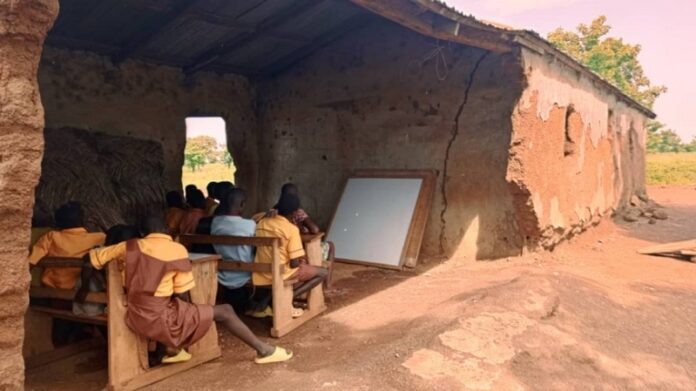As Ghana continues its efforts to provide quality education for all, communities like Tinsung in the Mion District of the Northern Region require urgent attention to ensure no child is left behind.
Pupils at the Tinsung Fathul-Mubeen Islamic primary school are studying in deplorable conditions, with the school’s structure posing serious risks to their safety and well-being.
The mud-based building, with crumbling walls and rusted, dilapidated roofing, fails to provide a secure environment, making teaching and learning challenging, especially when it rains.

Large portions of the walls are missing, and the sagging roof, weakened by years of neglect, exacerbates the situation.
Open holes in the walls, serving as makeshift windows, leave the classrooms exposed to harsh weather conditions.
Despite these dangerous conditions, the children attending this school are expected to sit for the same national exams as their peers in better-equipped schools across the country.
This glaring disparity raises urgent questions about equality in education and the need for immediate intervention to provide a safe learning environment for Tinsung’s pupils.

Community members are calling on authorities to take swift action to renovate the school and provide proper facilities for the children. They warn that the continued neglect of their school endangers both the students’ education and safety.
Dauda Sumailai, Chairman of the PTA at Tinsung Fathul-Mubeen Islamic Primary School, told Graphic Online that the school, built over 40 years ago by the community, has never been renovated.
He expressed concern that if the situation is not addressed, students will face further academic disadvantages in an already underserved district.
Chairman Sumailai also criticized successive governments for neglecting the community, highlighting that the lack of a decent school structure and teacher accommodation discourages teachers from staying in the area.
“Our major problem is a proper school building for our children,” he lamented.
“We’ve been urged to send our children to school, but as you can see, this building isn’t suitable for learning. The mud structure you see was built by community members 40 years ago, yet no government, not even the Mion District Assembly, has considered building us a modern, well-furnished classroom block.”
Tinalibei Jijiri Yildana, a teacher and native of the community who has been teaching at the school for two years, said the poor conditions are affecting academic performance and called on the government and charitable organizations to assist.

“I feel sad every time I enter the classroom to teach,” he said. “This school is older than me. It was built by our parents in 1985 before I was born. I studied here in the same conditions and became a teacher. When I got my post, I chose to return and help my community, but the situation remained unchanged. The school was nearly collapsing as enrolment was dropping. However, we kept pushing, and now we have over 300 students enrolled.”
Yildana emphasized that many teachers refuse to stay after seeing the state of the school, leading to chronic staff shortages.
“We have four teachers, including one Arabic instructor, but only three are currently on post. One handles the Junior High School. Teachers come from far away, and upon seeing the structure, they run away. Some request transfers, while others leave without notice.”
Haruna Amidu, a basic six pupil, expressed his frustration with how classes are disrupted whenever it rains. He also lamented the lack of teaching materials and furniture at the school and appealed to benevolent organizations and individuals for help.









ALSO READ:


